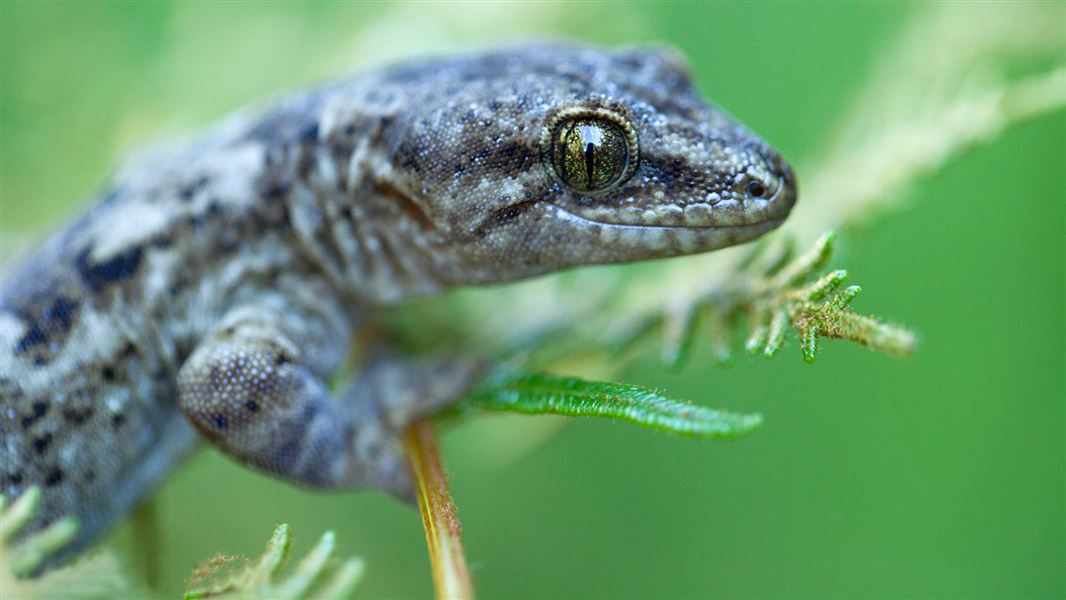There are 48 species of gecko in New Zealand. They are found throughout the country on the main islands and most offshore islands.
Geckos inhabit a variety of habitat types from sea level to 2200 m above it. These include forests, tussock grasslands and rock outcrops. We have found new species as we learn more and search new places.
How to identify geckos
One way you can identify geckos is by their sounds. Geckos can vocalise and many New Zealand species make a chirping sound. Green geckos are also quite loud for their size and produce a sound more like a ‘bark’.
Did you know?
Duvaucel’s gecko is the largest living gecko in New Zealand and one of the biggest in the world.
It can grow 160 mm from nose to the top of the tail, and weigh up to 120 g.
You can also identify some geckos by how they climb. Many can climb sheer surfaces because they have ‘sticky’ feet. These geckos have toes that are covered with microscopic hairs, allowing them to climb smooth surfaces and walk upside down.
Unlike skinks, geckos do not have moveable eyelids and cannot blink. Instead, they have a clear scale that protects the eye. You may see them licking their eyes – they do this to keep them clean.
New Zealand geckos are omnivores. If you catch them eating, you might see them eating insects like moths and flies, which are their main food. But they also enjoy the berries and nectar of some plants and flowers.
Breeding and lifespan
In New Zealand, geckos are extremely slow breeding and usually have one or two young. Many geckos only breed once a year, with some species only breeding once every two years.
However, geckos are also long-lived. Some geckos have been shown to live for over 50 years in the wild.
New Zealand geckos are also unusual in that they give birth to live young rather than laying eggs. The only other geckos that do this live in New Caledonia.
Threats
There are two main threats to geckos: predation and habitat destruction.
Predation
Our geckos are at risk from introduced predators. They can be preyed upon by mice, rats, hedgehogs, weasels, stoats, ferrets, cats, possums and pigs.
Most of these predators are active at night and hunt on the ground. This means larger, ground-dwelling animals are more at risk than smaller, tree-dwelling ones. So smaller species of lizards can seek shelter in small crevices to avoid predators. But larger lizards are more vulnerable because they have limited safe retreats to hide in.
Habitat destruction
The loss of their home is also a big threat to our native geckos. Although there is a lot less destruction of their habitats than has been in the past, it remains a serious threat to them.
Enormous areas of tussock land and scrublands that geckos depend on are cleared for development or pasture. When tussock grasslands are burned, ploughed and converted to pasture, this can threaten the lives of the geckos that live there.
Our work for gecko conservation
We work to help gecko populations grow by finding and recording them. We do this to gain a better understanding of what species we have, where they are found and how healthy their populations are. New species are still being discovered.
DOC has created many predator-free offshore islands. Removing predators helps gecko populations to grow, which can also help us to find and record them.
We have been able to safely move some native gecko species to these islands. This has helped these populations to thrive. For example, Pacific geckos have been moved by this method.
We successfully translocated Pacific geckos to Lady Alice Island in the Hen and Chickens group. This was made possible by DOC’s work to successfully eradicate rats/kiore from the island.
Geckos have been able to survive on islands with introduced predators in tiny numbers by hiding in safe refuges like steep cliffs. But it can take many years, after predators have been removed, for geckos to increase their numbers and spread so we can detect them.
For example, Raukawa geckos were found on Tiritiri Matangi Island for the first time in 2004, after rats were eradicated in 1993.
You can help
Report gecko sightings
Information about how to:
If possible, record the exact location where you saw the gecko. If you can, include details of the surrounding area. A photo is extremely helpful if you’re able to take one.
Provide habitats for geckos
You can encourage geckos to visit your garden by providing rocks and large areas of dense, spreading shrubs, like coprosma and muehlenbeckia. These will not only provide safe cover but will also provide fruit and attract insects for geckos to feed on.
Help stop gecko smuggling
Some gecko species are being illegally removed from the wild for the international reptile trade. You can help stop this by reporting suspicious activities and vehicle licence numbers to our 24-hour hotline, 0800 DOC HOT (0800 362 468).
